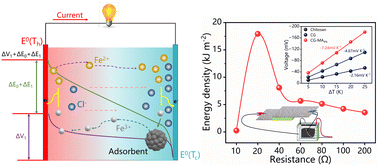Double selective ionic gel with excellent thermopower and ultra-high energy density for low-quality thermal energy harvesting†
Abstract
The high thermopower characteristics of ionic thermoelectric cells (ITECs) significantly improve the efficiency of environmental heat and energy collection and utilization. Herein, based on the low thermal conductivity of biomass materials, we propose a novel strategy on structural design and component modulation for full component utilization and synergistic enhancement of thermodiffusion and thermogalvanic effects of single electrolytes to achieve high thermopower and output energy density. Grafting guanidinium salt ions in the chitosan gel can facilitate the selective separation of positive and negative ions of the FeCl3/2 electrolyte and enhance the thermodiffusion effect. Meanwhile, introduction of melamine in the chitosan gel enables the selective complexation/desorption of Fe3+ at cold and hot ends, which enlarges the concentration and entropy difference of redox pairs in electrolyte ions. Significant magnification of the thermocouple effect is observed, resulting in 700% increase in thermopower (−1.04 to −7.24 mV K−1). Particularly, the 90-min output energy density of the ITECs reaches 17.93 kJ m−2 at ΔT of 25 K, which is a record-breaking result among the reported quasi-solid-state ITECs. This study provides a new design pathway for development and application of high-performance ITECs.

- This article is part of the themed collection: Energy & Environmental Science Recent HOT Articles


 Please wait while we load your content...
Please wait while we load your content...